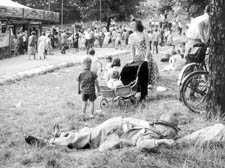|
|
 |
| |

Fair on Hampstead Heath |
England as seen by a loving foreigner
PHOTOGRAPHER John Gay loved England. He spent his career chronicling daily life and a new exhibition picked from his archive of 40,000 images will grace the walls of Kenwood House, Hampstead.
But for someone who made his name as the photographer of quintessential English society, his background was surprising. He was born in Germany in 1909 and arrived in Britain in the mid-1930s, where he changed his German name of Hans Gohler to John Gay, allegedly after seeing a production of the 18th-century dramatist’s Beggar’s Opera.
He used his adopted home as his subject matter, and his observations fitted the period. He’d arrived at a time when government-sponsored propaganda films and newsreels reminded people of what they would soon be fighting for – the England George Orwell described as a place where “...the beer is bitterer, the coins are heavier, the grass is greener”.
His route to London was forced by political events of the early 1930s. Disgusted by the Nazi regime, he came to Britain, settled in St Albans Road, Parliament Hill Fields, and began work as a freelance photographer.
Gay approached his work with patience and inventiveness. His observations of every-day life – be it washing billowing on lines or cats licking their paws – were taken from hours of watching, waiting. But he also had a way of approaching his subjects: always after an eye-catching angle, he built a rack on top of his Morris car that allowed him to hook a step ladder to the roof. He’d pull up by something he wanted to photograph and then climb to the precarious vantage point to get a birds-eye view.
His range was vast, from straightforward portraits to documenting the way the English played out their lives. From the glamour of photographing the likes of actress Honor Blackman to a farmer and his dog, from a portrait of JB Priestley, pipe in mouth playing snooker, to a down-and-out man on Blackfriars Bridge, he captured the essence of England. He also charted the changes in the city he had grown to love: working for architects, he chronicled the Bauhaus and modernist movements as post-war British cities were rebuilt. He went on to produce his own books, using a literary collaborators to provide words – including Sir John Betjeman. The product of their work was London’s Historic Railway Stations, published in 1971. This led on to his next project, Highgate Cemetery: A Victorian Valhalla.
John actually died in the cemetery in 1999 while working there as a volunteer– he was also a founding member of the Highgate Society. He would spend his Sunday’s gardening among the graves and was responsible for the appreciation of the cemetery as a natural haven as well as the resting place of the 19th-century’s great and good.
In 1979, John approached the National Monuments Record and asked them if they would take his work after his death: this exhibition has drawn on this bequest. And it is fitting that Kenwood House should be the venue for a major exhibition of John’s work: he asked his wife Marie to marry him as they strolled through the grounds.
DAN CARRIER
• |

|
 |
|
 |
|

